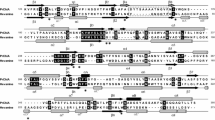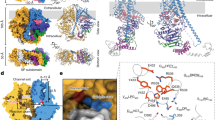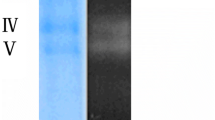Abstract
A family 19 chitinase (OsChia1c, class I) from rice, Oryza sativa L., and its chitin-binding domain-truncated mutant (OsChia1cΔCBD, class II) were produced by the Pichia expression system, and the hydrolytic mechanism toward N-acetylglucosamine hexasaccharide [(GlcNAc)6] was investigated by HPLC analysis of the reaction products. The profile of the time-course of (GlcNAc)6 degradation obtained by OsChia1c was identical to that obtained by OsChia1cΔCBD, indicating that the chitin-binding domain does not significantly participate in oligosaccharide hydrolysis. From the theoretical analysis of the reaction time-course of OsChia1cΔCBD, the free energy changes of sugar residue binding were estimated to be −0.4, −4.7, +3.4, −0.5, −2.3, and −1.0 kcal/mol for the individual subsites of (−3), (−2), (−1), (+1), (+2), and (+3), respectively. The hexasaccharide substrate appears to bind to the enzyme through interactions at the high-affinity sites, (−2) and (+2), and the sugar residues at both ends more loosely bind to the corresponding subsites, (−3) and (+3). The docking study of (GlcNAc)6 with the modeled structure of OsChia1cΔCBD supported the subsite structure estimated from the experimental time-course of hexasaccharide degradation. Since the class II chitinase from barley seeds was reported to possess a similar subsite structure from (−3) to (+3) and a similar free energy distribution, substrate-binding mode of plant chitinases of this class would be similar to each other.
Similar content being viewed by others
References
Andersen, M.D., Jensen, A., Robertus, J.D., Leah, R. and Skriver, K. 1997. Heterologous expression and characterization of wildtype and mutant forms of a 26 kDa endochitinase from barley (Hordeum vulgare L.). Biochem. J. 322: 815–822.
Brameld K.A. and Goddard, W. A. III. 1998. The role of enzyme distortion in the single displacement mechanism of family 19 chitinases. Proc. Natl. Acad. Sci. USA 95: 4276–4281.
Brunner, F., Stintzi, A., Fritig, B. and Legrand, M. 1998. Substrate specificities of tobacco chitinases. Plant J. 14: 225–234.
Collinge, D.B., Kragh, K.M., Mikkelsen, J.D., Nielsen, K.K., Rasmussen, U. and Vad, K. 1993. Plant chitinases. Plant J. 3: 31–40.
Fukamizo, T. 2000. Chitinolytic enzymes: catalysis, substrate binding, and their application. Curr. Protein Peptide Sci. 1: 105–124.
Fukamizo, T. and Hayashi, K. 1982. Separation and mutarotation of anomers of chitooligosaccharides. J. Biochem. 91: 619–626.
Fukamizo, T., Minematsu, T., Yanase. Y., Hayashi, K. and Goto, S. 1986. Substrate size dependence of lysozyme-catalyzed reaction. Arch. Biochem. Biophys. 250: 312–321.
Fukamizo, T., Sasaki C., Schelp, E., Bortone, K. and Robertus, J.D. 2001. Kinetic Properties of chitinase-1 from the fungal pathogen Coccidioides immitis. Biochemistry 40: 2448–2454.
Hart, P.J., Pfluger, H.D., Monzingo, A.F., Hollis, T. and Robertus, J.D. 1995. The refined crystal structure of an endochitinase from Hordeum vulgare L. seeds at 1.8 A resolution. J. Mol. Biol. 248: 402–413.
Henrissat, B. and Bairoch, A. 1993. New families in the classification of glycosyl hydrolases based on amino acid sequence similarities. Biochem. J. 293: 781–788.
Hollis, T., Honda, Y., Fukamizo, T., Marcotte, E., Day, P.J. and Robertus, J.D. 1997. Kinetic analysis of barley chitinase. Arch. Biochem. Biophys. 344: 335–342.
Honda, Y. and Fukamizo, T. 1998. Substrate binding subsites of chitinase from barley seeds and lysozyme from goose egg white. Biochem. Biophys. Acta 1388: 53–65.
Hong, J.K. and Hwang, B.K. 2002. Induction by pathogen, salt and drought of a basic class II chitinase mRNA and its in situ localization in pepper (Capsicum annuum). Physiol. Plant. 114: 549–558.
Imoto, T., Johnson, L.N., North, A.C.T., Phillips, D.C. and Rupley, J.A. 1972. Vertebrate lysozyme. In: P.D. Boyer (Ed.) The Enzymes, 3rd ed., vol. 7, Academic Press, New York, pp. 665–868.
Koga, D., Yoshioka, T. and Arakane, Y. 1998. HPLC Analysis of Anomeric Formation and Cleavage Pattern by Chitinolytic Enzyme. Biosci. Biotechnol. Biochem. 62: 1643–1646.
Kuhara, S., Ezaki, E., Fukamizo, T. and Hayashi, K. 1982. Estimation of the free energy change of substrate binding lysozymecatalyzed reactions. J. Biochem. 92: 121–127.
Laskowski R.A., MacArthur, M.W., Moss, D.S. and Thornton, J.M. 1993. PROCHECK: a program to check the stereochemical quality of protein structures. J. Appl. Crystallog. 26: 283–291.
Neuhaus, J.-M., Fritig, B., Linthorst, H.J.M., Meins, F., Mikkelsen, J.D. and Ryals, J. 1996. A revised nomenclature for chitinase genes. Plant Mol. Biol. Rep. 14: 102–104.
Nishizawa, Y., Kishimoto, N., Saito, A. and Hibi, T. 1993. Sequence variation, differential expression and chromosomal location of rice chitinase genes. Mol. Gen. Genet. 241: 1–10.
Park, S.-M., Truong, N. H. and Itoh, Y. 2002. Heterologous expression and characterization of class III chitinases from rice (Oryza sativa L.). Enzyme Microb. Technol. 30, in press.
Pihakaski-Maunsbach, K., Moffatt, B., Testillano, P., Risueno, M., Yeh, S., Griffith, M. and Maunsbach, A.B. 2001. Genes encoding chitinase-antifreeze proteins are regulated by cold and expressed by all cell types in winter rye shoots. Physiol. Plant. 112: 359–371.
Sasaki, C., Yokoyama, A., Itoh, Y., Hashimoto, M., Watanabe, T. and Fukamizo, T. 2002. Comparative study of the reaction mechanism of family 18 chitinases from plants and microbes. J. Biochem. 131: 557–564.
Truong, N.-H., Park, S.-M., Nishizawa, Y., Watanabe, T., Yamamoto, K., Sasaki, T. and Itoh, Y. 1998. Characterization of a Novel Type Class III Chitinase from Rice (Oryza sativa L.): Comparison with a Class I Chitinase. In: Ohmiya et al. (Ed.) Biochemistry and Ecology of Cellulose Degradation, UNI publishers, Tokyo, pp. 720–728.
Watanabe, T., Itoh, Y., Yamada, T., Hashimoto, M., Sekine, S. and Tanaka, H. 1994. The Role of C-Terminal Domain and Type III Domains of Chitinases A1 from Bacillus circulans WL-12 in Chitin Degradation. J. Bact. 176: 4465–4472.
Yanase, Y., Fukamizo, T., Hayashi, K. and Goto, S. 1987. Arch. Biochem. Biophys. 253: 168–175.
Zhong, R., Kays, S.J., Schroeder, B.P. and Ye, Z.-H. 2002. Mutation of a Chitinase-Like Gene Causes Ectopic Deposition of Lignin, Aberrant Cell Shapes, and Overproduction of Ethylene. Plant Cell 14: 165–179.
Zhu, X., Zhang, H., Fukamizo, T., Muthukrishnan, S. and Kramer, K.J. 2001. Properties of Manduca sexta chitinase and its C-terminal deletions. Insect Biochem. Mol. Biol. 31: 1221–1230.
Author information
Authors and Affiliations
Corresponding author
Rights and permissions
About this article
Cite this article
Sasaki, C., Itoh, Y., Takehara, H. et al. Family 19 chitinase from rice (Oryza sativa L.): substrate-binding subsites demonstrated by kinetic and molecular modeling studies. Plant Mol Biol 52, 43–52 (2003). https://doi.org/10.1023/A:1023972007681
Issue Date:
DOI: https://doi.org/10.1023/A:1023972007681




